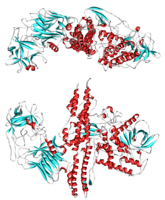
Photo from wikipedia
Spasticity is a common disabling disorder in adult subjects suffering from stroke, brain injury, multiple sclerosis (MS) and spinal cord injury (SCI). Spasticity may be a disabling symptom in people… Click to show full abstract
Spasticity is a common disabling disorder in adult subjects suffering from stroke, brain injury, multiple sclerosis (MS) and spinal cord injury (SCI). Spasticity may be a disabling symptom in people during rehabilitation and botulinum toxin type A (BTX-A) has become the first-line therapy for the local form. High BTX-A doses are often used in clinical practice. Advantages and limitations are debated and the evidence is unclear. Therefore, we analysed the efficacy, safety and evidence for BTX-A high doses. Studies published from January 1989 to February 2020 were retrieved from MEDLINE/PubMed, Embase, Cochrane Central Register. Only obabotulinumtoxinA (obaBTX-A), onabotulinumtoxinA (onaBTX-A), and incobotulinumtoxinA (incoBTX-A) were considered. The term “high dosage” indicated ≥ 600 U. Thirteen studies met the inclusion criteria. Studies had variable method designs, sample sizes and aims, with only two randomised controlled trials. IncoBTX-A and onaBTX-A were injected in three and eight studies, respectively. BTX-A high doses were used predominantly in treating post-stroke spasticity. No studies were retrieved regarding treating spasticity in MS and SCI. Dosage of BTX-A up to 840 U resulted efficacious and safety without no serious adverse events (AEs). Evidence is insufficient to recommend high BTX-A use in clinical practice, but in selected patients, the benefits of high dose BTX-A may be clinically acceptable.
Journal Title: Toxins
Year Published: 2020
Link to full text (if available)
Share on Social Media: Sign Up to like & get
recommendations!